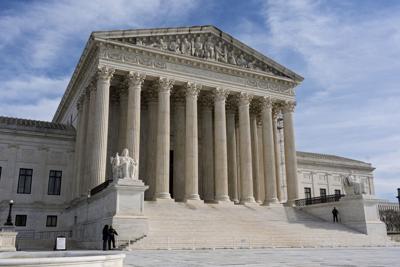WASHINGTON — The Supreme Court is allowing President Donald Trump to put his plan to dismantle the Education Department back on track — and to go through with laying off nearly 1,400 employees.
With the three liberal justices in dissent, the court on Monday paused an order from U.S. District Judge Myong Joun in Boston, who issued a preliminary injunction reversing the layoffs and calling into question the broader plan. The layoffs “will likely cripple the department,” Joun wrote. A federal appeals court refused to put the order on hold while the administration appealed.
The high court action enables the administration to resume work on winding down the department, one of Trump's biggest campaign promises.

The Supreme Court is seen Dec. 17 on Capitol Hill in Washington.Â
In a post Monday night on his social media platform, Trump said the high court “has handed a Major Victory to Parents and Students across the Country.” He said the decision will allow his administration to begin the “very important process” of returning many of the department’s functions “BACK TO THE STATES.”
People are also reading…
The court did not explain its decision in favor of Trump, as is customary in emergency appeals. But in dissent, Justice Sonia Sotomayor complained that her colleagues were enabling legally questionable action on the part of the administration.
“When the Executive publicly announces its intent to break the law, and then executes on that promise, it is the Judiciary’s duty to check that lawlessness, not expedite it,” Sotomayor wrote for herself and Justices Ketanji Brown Jackson and Elena Kagan.
The secretary of education lauds the decision
Education Secretary Linda McMahon said it’s a “shame” it took the Supreme Court’s intervention to let Trump’s plan move ahead.
“Today, the Supreme Court again confirmed the obvious: the President of the United States, as the head of the Executive Branch, has the ultimate authority to make decisions about staffing levels, administrative organization, and day-to-day operations of federal agencies,” McMahon said in a statement.
A lawyer for the Massachusetts cities and education groups that sued over the plan said the lawsuit will continue, adding no court has yet ruled that what the administration wants to do is legal.
“Without explaining to the American people its reasoning, a majority of justices on the U.S. Supreme Court have dealt a devastating blow to this nation’s promise of public education for all children. On its shadow docket, the Court has yet again ruled to overturn the decision of two lower courts without argument,” Skye Perryman, president and CEO of Democracy Forward, said in a statement.
The Supreme Court has handed Trump one victory after another in his effort to remake the federal government, after lower courts have found the administration's actions probably violate federal law. Last week, the justices cleared the way for Trump's plan to significantly reduce the size of the federal workforce. On the education front, the high court has previously allowed cuts in teacher-training grants to go forward.
Separately on Monday, more than 20 states sued the administration over billions of dollars in frozen education funding for after-school care, summer programs and more.
Education Department employees are on leave
Education Department employees who were targeted by the layoffs have been on paid leave since March, according to a union that represents some of the agency’s staff.
Joun’s order had prevented the department from fully terminating them, though none had been allowed to return to work, according to the American Federation of Government Employees Local 252. Without Joun’s order, the workers would have been terminated in early June.
The Education Department had said earlier in June that it was “actively assessing how to reintegrate” the employees. A department email asked them to share whether they had gained other employment, saying the request was meant to “support a smooth and informed return to duty.”
The current case involves two consolidated lawsuits that said Trump’s plan amounted to an illegal closure of the Education Department.
One suit was filed by the Somerville and Easthampton school districts in Massachusetts along with the American Federation of Teachers and other education groups. The other legal action was filed by a coalition of 21 Democratic attorneys general.
The suits argued that layoffs left the department unable to carry out responsibilities required by Congress, including duties to support special education, distribute financial aid and enforce civil rights laws.















